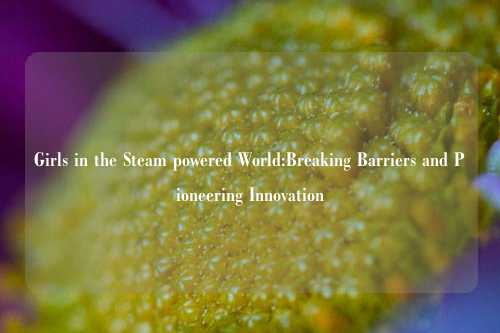Introduction
In a world often envisioned as dominated by male - centric technological pursuits, the emergence of "Girls in Steam" has been a refreshing and transformative phenomenon. The term "Steam" encompasses Science, Technology, Engineering, the Arts, and Mathematics, a broad and dynamic field that has historically been underrepresented by women, especially girls. However, in recent years, there has been a growing movement of girls stepping into the Steam arena, shattering stereotypes, and making remarkable contributions. This article delves into the significance of girls in Steam, the challenges they face, the impact they are having, and the steps needed to further encourage their participation.
The Rise of Girls in Steam
The seeds of the girls - in - Steam movement were sown as society began to recognize the importance of diversity in innovation. As the digital age advanced, the demand for a workforce proficient in Steam fields skyrocketed. At the same time, there was a growing awareness of the gender gap in these areas. Educational institutions, non - profit organizations, and technology companies started initiatives to encourage girls to explore Steam subjects from an early age.

One of the key factors contributing to the rise of girls in Steam is the increasing visibility of female role models. Women like Marie Curie, Ada Lovelace, and Grace Hopper, who made significant contributions to science and technology in eras when gender discrimination was rife, have become inspiration for young girls. Modern - day female scientists, engineers, and artists in Steam fields are also actively promoting their work, sharing their stories, and mentoring young girls. For example, there are female software engineers who have developed popular mobile applications, female roboticists who are pushing the boundaries of artificial intelligence, and female artists who are merging technology with creative expression through digital art forms.
Another important aspect is the development of educational programs specifically designed to engage girls in Steam. These programs often incorporate hands - on learning experiences, real - world applications, and collaborative projects. For instance, coding camps for girls, where they learn to create their own video games or mobile applications, have become increasingly popular. Robotics competitions that encourage girls to build and program robots are also on the rise. These initiatives make Steam subjects more accessible and appealing to girls, showing them that these fields can be fun, creative, and rewarding.
Challenges Faced by Girls in Steam
Despite the progress made, girls in Steam still face a plethora of challenges. One of the most significant obstacles is gender stereotypes. From a young age, girls are often exposed to societal messages that suggest that Steam fields are more suitable for boys. Toys and media play a role in this. Traditional toy marketing often targets boys with building sets, science kits, and engineering - themed toys, while girls are more likely to be presented with dolls and fashion - related playthings. Media representations also tend to depict male characters as the ones involved in scientific and technological pursuits, further reinforcing these stereotypes.
In the classroom, girls may face a lack of encouragement or even subtle discrimination. Teachers, whether consciously or unconsciously, may give more attention or praise to boys in Steam - related subjects. This can lead to girls feeling less confident in their abilities and less likely to pursue these fields further. Additionally, group work in Steam classes can sometimes be dominated by boys, leaving girls with fewer opportunities to contribute and showcase their skills.
Another challenge is the lack of female peers and mentors in Steam environments. In many schools and workplaces, the proportion of girls and women in Steam courses and jobs is still relatively low. This can make it difficult for girls to find like - minded individuals to collaborate with or to look up to for support and guidance. The isolation can be demotivating and may cause some girls to drop out of Steam - related programs or careers.
The pressure to conform to traditional gender roles also takes a toll on girls in Steam. They may face criticism from family, friends, or society for choosing a non - traditional path. The fear of being seen as "unfeminine" or going against the norm can be a significant deterrent, especially during adolescence when social acceptance is highly valued.
Impact of Girls in Steam
The presence of girls in Steam has far - reaching positive impacts, both on an individual and a societal level. On an individual level, girls who engage in Steam activities develop a wide range of valuable skills. They learn critical thinking, problem - solving, creativity, and perseverance. These skills are not only essential for success in Steam fields but also for navigating life in general. For example, the ability to think critically and solve complex problems can be applied in various aspects of life, from making personal decisions to contributing to community projects.
Girls in Steam also gain a sense of empowerment and self - confidence. When they achieve success in a field that has been traditionally male - dominated, they break free from the shackles of gender stereotypes. They realize their own capabilities and potential, which can have a positive impact on their self - esteem and overall well - being. This newfound confidence can spill over into other areas of their lives, enabling them to take on more challenges and pursue their dreams.
On a societal level, the contributions of girls in Steam are crucial for innovation and economic growth. A diverse workforce in Steam fields brings different perspectives and ideas to the table. Girls and women, with their unique life experiences and ways of thinking, can come up with solutions to problems that may have been overlooked by a more homogeneous group. For example, in the development of healthcare technology, female engineers and scientists may be more attuned to the specific needs of female patients, leading to the creation of more effective and user - friendly medical devices.
Moreover, as girls in Steam grow up to become professionals in these fields, they can inspire the next generation of girls. By serving as role models themselves, they can show younger girls that it is possible to succeed in Steam and that these fields are open to them. This creates a positive cycle of increasing female participation in Steam, leading to greater diversity and more innovation in the long run.
Encouraging More Girls in Steam
To further encourage girls to engage in Steam, several steps need to be taken. First and foremost, there needs to be a change in societal attitudes and stereotypes. This can be achieved through education and awareness - raising campaigns. Parents, teachers, and the media all have a role to play. Parents can expose their daughters to a wide range of toys and activities from an early age, including those related to Steam. Teachers can receive training on how to create an inclusive and supportive classroom environment for all students, regardless of gender. The media can feature more positive and diverse representations of girls and women in Steam fields.
Educational institutions should also play a more proactive role. They can offer more Steam - related courses and extracurricular activities specifically designed for girls. These programs should focus on making the learning experience enjoyable and relevant to girls' interests. For example, they can incorporate themes such as fashion technology, environmental science, or digital storytelling to make the subjects more appealing. Schools can also organize mentorship programs that pair girls with female professionals in Steam fields, providing them with guidance, support, and real - world insights.
Workplaces also have a responsibility to create a more inclusive environment for girls and women in Steam. Technology companies, research institutions, and other organizations in Steam - related industries should implement policies to promote gender equality. This includes equal pay, flexible work arrangements, and opportunities for career advancement. By creating a supportive and inclusive work environment, they can attract and retain more female talent in the long run.
Non - profit organizations and community groups can also contribute significantly. They can organize events, workshops, and competitions that specifically target girls in Steam. These activities can provide a platform for girls to showcase their skills, network with like - minded individuals, and learn from experts in the field.
Conclusion
The movement of girls in Steam is a powerful force for change in our society. It challenges traditional gender norms, promotes innovation, and empowers girls to reach their full potential. While there are still many challenges to overcome, the progress made so far is encouraging. By working together as a society, we can create an environment where every girl has the opportunity to explore and thrive in Steam fields. Whether it's through changing societal attitudes, improving education, or creating inclusive workplaces, we have the power to ensure that the future of Steam is diverse, inclusive, and filled with the creativity and talent of girls and women. As we continue to break down barriers and encourage more girls in Steam, we are not only shaping the future of these fields but also building a more equitable and innovative world for all.


还没有评论,来说两句吧...